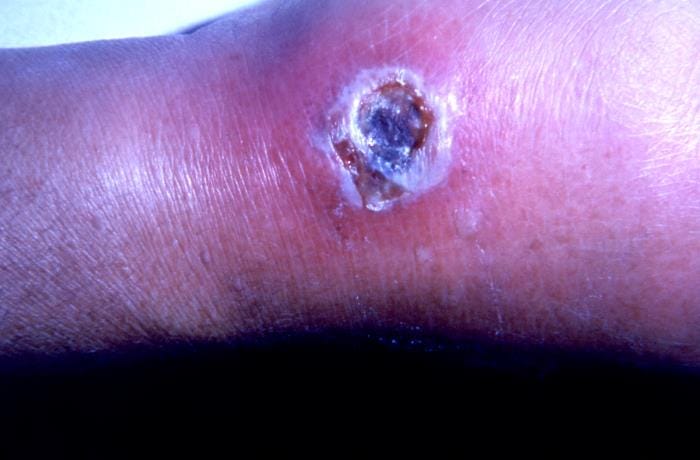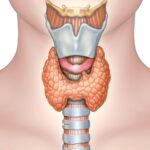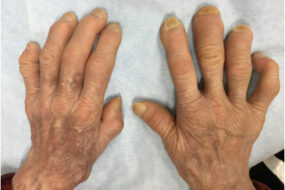- Home
- INTERNAL MEDICINE
- Anthrax

Anthrax is a zoonotic infection caused by Bacillus anthracis, a gram-positive, spore-forming, rod-shaped bacterium. The spores can survive in harsh environmental conditions for decades, posing significant risks, particularly in endemic regions.
Humans typically acquire anthrax through direct contact with infected animals or their products. While rare, cases of inhalational anthrax can also arise from intentional spore release (bioterrorism).
Epidemiology
- Geographical distribution: Anthrax is endemic in parts of Africa, Asia, and the Middle East, with sporadic cases reported in the Americas and Europe. Outbreaks often occur in agricultural settings where animals are not routinely vaccinated.
- Transmission routes: Infection typically occurs through cutaneous exposure (95% of cases), ingestion of undercooked contaminated meat, or inhalation of spores.
Pathophysiology
The pathogenicity of B. anthracis is mediated by its toxin production and protective capsule:
- Capsule: Composed of poly-D-glutamic acid, this capsule prevents phagocytosis by host immune cells.
- Toxins: The bacterium produces three toxins—protective antigen (PA), lethal factor (LF), and edema factor (EF). These combine to form two binary toxins:
- Edema toxin (PA + EF): Causes local swelling and impairs immune response.
- Lethal toxin (PA + LF): Disrupts cellular signaling, leading to cell death and systemic effects.
Clinical Manifestations
Anthrax can present in four main forms:
- Cutaneous Anthrax
- Most common form (95%).
- Pathogenesis: Occurs when spores enter broken skin, leading to local infection.
- Presentation:
- Initial papule develops into a vesicle, which ruptures, forming a painless ulcer with a characteristic black eschar.
- Surrounding edema and lymphadenopathy are common.
- Mortality: If untreated, mortality can reach up to 20%; with antibiotics, it drops below 1%.
- Inhalational Anthrax
- Most lethal form, with mortality rates of up to 85% if untreated.
- Pathogenesis: Inhaled spores are phagocytosed by alveolar macrophages, transported to lymph nodes, where they germinate, leading to a hemorrhagic mediastinitis.
- Presentation:
- Biphasic course: Initially, nonspecific flu-like symptoms (fever, cough, myalgia). Progresses to severe respiratory distress, shock, and potentially meningitis.
- Widened mediastinum on chest radiography is a classic finding.
- Gastrointestinal Anthrax
- Results from ingestion of contaminated meat.
- Two forms: Oropharyngeal (ulcers in the mouth and throat with cervical lymphadenopathy) and abdominal (nausea, vomiting, bloody diarrhea).
- Mortality: High if untreated (25-60%).
- Injection Anthrax
- Recently described form seen in heroin users.
- Presentation: Severe soft-tissue infection, compartment syndrome, sepsis, and multiple organ failure.
Diagnostic Approach
- Laboratory Diagnosis:
- Gram stain and culture: Direct examination of samples from cutaneous lesions, blood, or pleural fluid. B. anthracis appears as large, gram-positive rods.
- Polymerase Chain Reaction (PCR) and Immunohistochemistry: Useful for detecting anthrax antigens and DNA in clinical specimens.
- Serology: Can confirm exposure, but may not be timely for acute management.
- Imaging:
- Chest X-ray/CT: Mediastinal widening in inhalational anthrax is a key diagnostic clue.
Treatment Guidelines
- Antibiotics (Include dosage and duration):
- Ciprofloxacin: 400 mg IV every 8-12 hours or 500-750 mg orally twice daily for 60 days.
- Doxycycline: 100 mg IV every 12 hours or 100 mg orally twice daily for 60 days.
- Combination Therapy: For inhalational, gastrointestinal, or injection anthrax, add a second agent like:
- Clindamycin: 900 mg IV every 8 hours.
- Rifampin: 300 mg orally twice daily.
- Duration: Typically 60 days for inhalational anthrax due to delayed spore germination.
- Antitoxin Therapy: monoclonal antibodies that target protective antigen, neutralizing the anthrax toxin.
- Raxibacumab: 40 mg/kg IV as a single dose.
- Obiltoxaximab: 16 mg/kg IV as a single dose.
- Usage: Recommended for inhalational anthrax in combination with antibiotics.
- Supportive Care:
- Ventilatory support: For respiratory distress in inhalational cases.
- Fluid resuscitation and vasopressors: For shock management.
- Post-Exposure Prophylaxis:
- Antibiotics: Ciprofloxacin 500 mg orally twice daily or doxycycline 100 mg orally twice daily for 60 days.
- Vaccination: Three doses of anthrax vaccine over four weeks post-exposure, alongside antibiotics.
Prevention Strategies
- Vaccination:
- Anthrax Vaccine Adsorbed (AVA): Given as a 5-dose series (0, 1, 6, 12, and 18 months) with annual boosters for high-risk populations.
- Post-exposure regimen: Three doses combined with 60 days of antibiotic prophylaxis.
- Environmental Control:
- Decontamination: Use of sporicidal agents (e.g., chlorine dioxide) to eliminate spores from contaminated environments.
- Animal Vaccination and Disposal: Vaccinating livestock in endemic areas and properly disposing of infected carcasses.
Complications
- Septicemia: Can arise from any form of anthrax, leading to systemic dissemination.
- Anthrax Meningitis: Occurs in about 5-10% of inhalational cases, characterized by hemorrhagic meningoencephalitis.
- Long-term Sequelae: May include chronic cutaneous scars or residual neurological deficits in survivors of anthrax meningitis.
Prognosis
- Cutaneous anthrax: Excellent prognosis with timely antibiotic therapy.
- Inhalational, gastrointestinal, or injection anthrax: Despite treatment, these forms are associated with higher mortality due to systemic complications.












